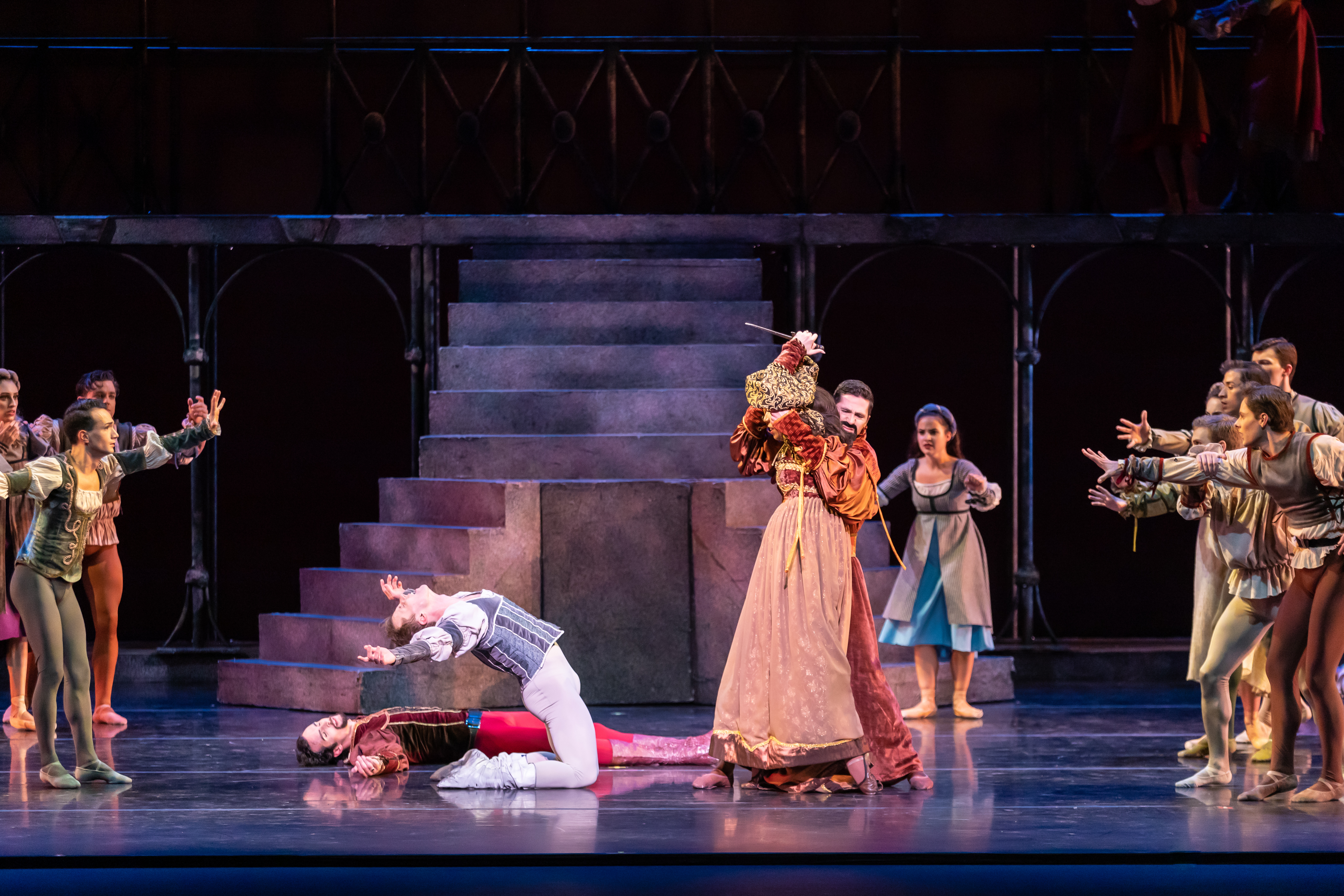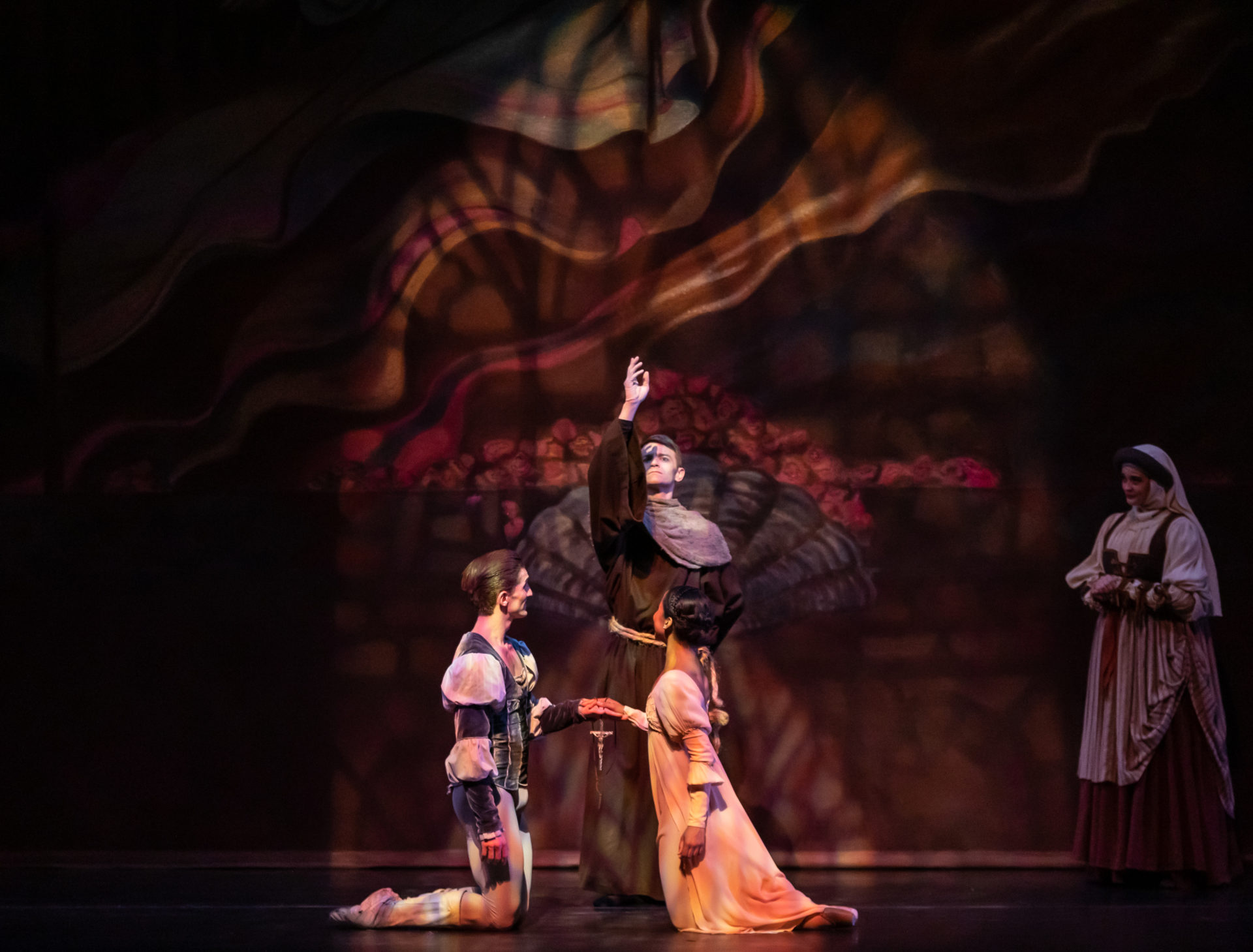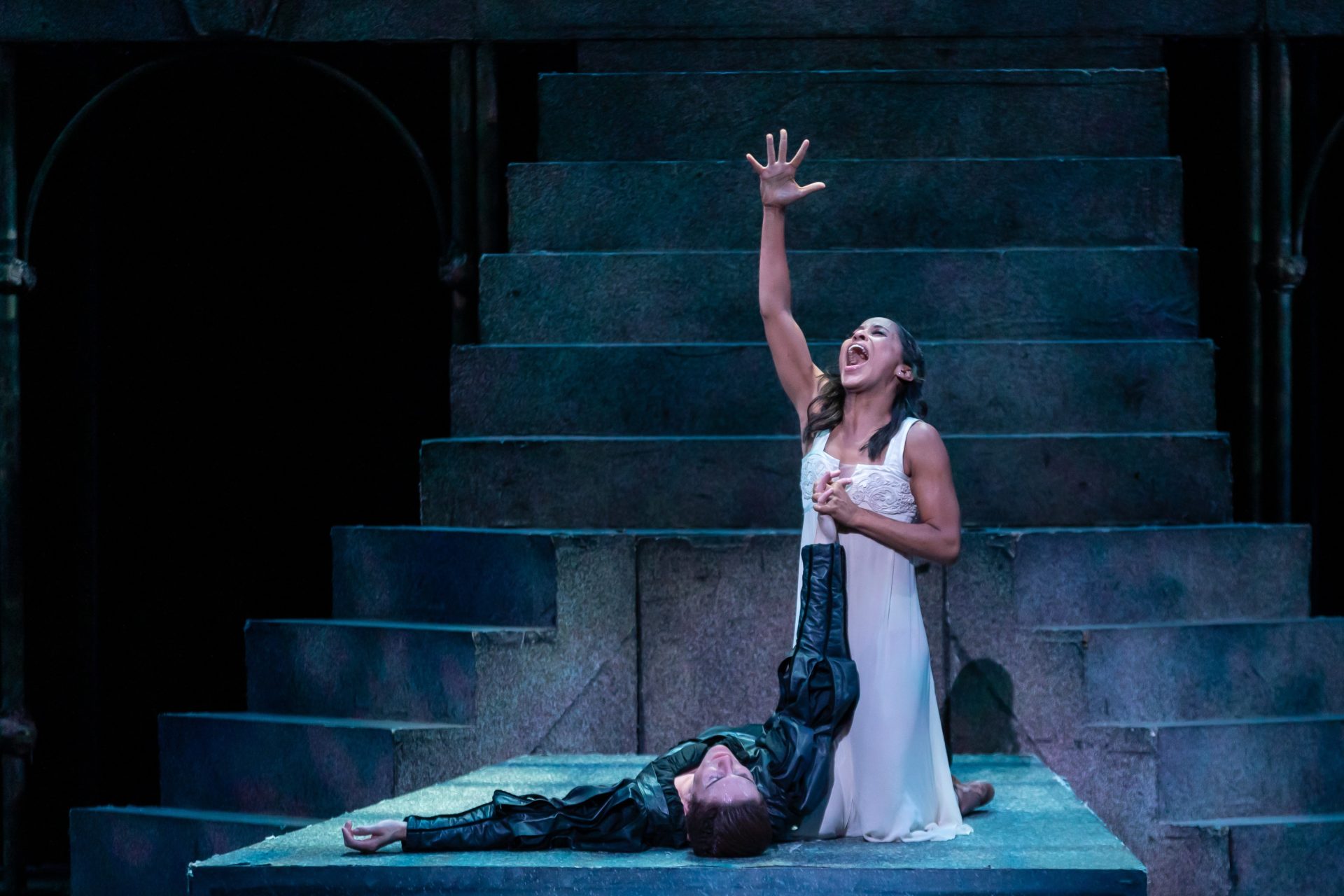Nashville Ballet Presents
Romeo and Juliet
Two households, both alike in dignity,
In fair Verona, where we lay our scene…
So begins the most renowned tragedy by William Shakespeare. Two brought so close by love yet ripped from the world they dreamed together by the reality of their family’s damning feud. The opening scrim of the Nashville Ballet’s Romeo and Juliet, an image that will remain as the link throughout the entire production, shows two angels- one in white with red accents, one in blue- intertwined by golden cloth. In typical Renaissance artistic style, the rendering depicts movement with their eyes looking down upon the earth as the flowing of their robes suggest their ascent toward the heavens. Already evocative of the play’s opening lines, this image sets the stage for what is to come.

When the orchestra begins the introduction to Sergei Prokofiev’s suggestive score, the lush sound of the Nashville Symphony’s string section fills the hall. The lights dim, and the heroic figure of our Romeo (Nicholas Scheuer) is illuminated. Thus, the opening ensemble number is initiated, a rambunctious exposition to each character. Romeo courts the elusive Rosalind (Mollie Sansone), Mercutio (Gerald Watson) the fierce Amante (Katie Vasilopolous). Many things happen concurrently, but the stage is arranged beautifully to accommodate the hustle. With two platforms upstage and a staircase linking them, the audience can view multiple moving parts without confusion on the scene’s focus. As more townspeople enter the street, tensions rise between the inhabitants of Verona. Romeo remains unaware of anything but Rosalind, even when Mercutio and Benvolio (Luca Sportelli) begin to engage with Tybalt (Owen Thorne) and his Capulet counterparts. An elegant fight scene commences, and Romeo finally joins the fray.

Red-clad Capulets and blue-robed Montagues duel in group features before breaking into individual brawls. Clamor and chaos ensue, and within the thick of it, a child is killed. When the Prince arrives, the two families are forced to make peace, and the scene closes on the two patriarchs (Jon Upleger, Capulet; Shabaz Ujima, Montague) shaking their fists at one another from afar. From there, the story plays as expected. An exquisite Juliet (Kayla Rowser), donned in white, is introduced with choreography that exhibits her joyous naïvete as the Nurse (Emily Ireland-Buczek) prepares her for the party. The Capulet party allows a few wonderful spotlights. Not only is the ensemble opening to the “The Dance of the Knights” both raucous and stately, but the sultry dance between Tybalt and the Lady Capulet (Julia Eisen) highlight an unusual relationship that doesn’t appear in all Romeo and Juliet interpretations (the play on the Medieval idea of courtly love here is intriguing). When the Montague boys take the stage in taunting trio, Benvolio steals the show with impeccable grace and a round of pirouettes. This particular combination of dancers is an absolute delight to watch, sold by Scheuer’s dynamic charm, Watson’s sharp wit, and Sportelli’s stunning movement.
At this point of the production, it becomes abundantly clear that the color scheme is an entire character unto its own. The use of the detailed costuming is brilliant- in their meeting, Romeo is in the lightest possible hue of the Montague blue, and Juliet remains in a pure white with gold accents. Gold appears to be the most neutral of colors, with both Paris and the Prince enrobed in it. Tybalt sports the strongest red of the Capulets, furthering the point that his fire for the family feud burns brightest. However, the color is not just utilized in the costuming; the lighting and set design will change to reflect the side to which we should be paying attention. The starkest instance of this occurs at the beginning of the third act, when the scrim is illuminated with a fractured blend of red and blue. Romeo has just killed Tybalt and been sent to exile by the Prince. It is notated in our program that the next scene will take place in Juliet’s bedroom after they have just consummated their marriage, and as the orchestra begins to play, the shards of blue dim while the red remain vibrant.
The multiple pas de deux that occur between Romeo and Juliet are entrancing conversations that highlight Juliet’s excitement and Romeo’s exuberance. They are an endearing match with Rowser’s lithe playfulness and Scheuer’s eager passion. Scheuer plays a different Romeo to the smoldering tortured soul of DiCaprio- he feels each emotion so fully and so genuinely that watching him come to the realization of what he’d done to Tybalt in the second act, this strong and elegant figure breaking as he fell under the weight of it all, was truly heartbreaking. Rowser’s own fluidity between the confidence of an en pointe stance to a lowered and meek posture when in the presence of her parents only adds to her incredible technical performance. Another standout was the death of Mercutio. His preceding pas de deux with Amante (which becomes a humorous trio with Benvolio) is delightfully twisted through Vasilopolous’ strength in movement and Watson’s charisma. Watson then commands the stage through his joking about his wounds (I could almost hear the infamous “Ay, ay, a scratch, a scratch”) to his powerful fall in the sign of the crucifix (the symbolism of the cross was rampant throughout the performance) as Tybalt watched on in jest. Thorne carried the role of villain well, smugly brushing off the errant booing from an audience member during the curtain call.

Prokofiev’s score plays like a narrator, giving the audience auditory cues to follow. He seemed to write in the dramatic irony that was rife throughout the third act. Unprecedented interjections and dissonances at cadential points of phrases during the love duet of Romeo and Juliet and the violin glissandi in the flute melody during Juliet’s brief pas de deux with Paris were especially sardonic. Also of note is the Russian composer’s experimentation with instrumentation- it’s not common to hear tenor saxophone or mandolin in an orchestral pit. The musicians of the Nashville Symphony achieved much in the almost continuous two hours of music: the musicality of the woodwind section in the introduction, the bassoon soli as the street livens, the principal flute’s delicacy when representing the innocent Juliet, the demanding horn fanfares during both the wedding and the funeral scenes, the Concertmaster’s beautiful solos throughout the ballet, and so many more.
In the introduction video to the production, artistic director Paul Vasterling speaks to the difficulty of adapting a show based on words into a nonverbal representation. “What we strive for in a ballet like Romeo and Juliet is to be able to tell this story through movement. There are no words. I want the audience to forget about that- to forget that there are no words.” From realistically stylized fight choreography to gorgeous, period-driven costuming, Romeo and Juliet succeeds in its mission. The marriage of the dancers’ emotive technique to a score dense with meaning, wrapped in beautifully crafted lighting plan and set design leaves the Nashville Ballet’s Romeo and Juliet a voice to speak for itself.
The Nashville Ballet returns on October 10th through the 14th with a production of Prokofiev’s Peter and the Wolf.



